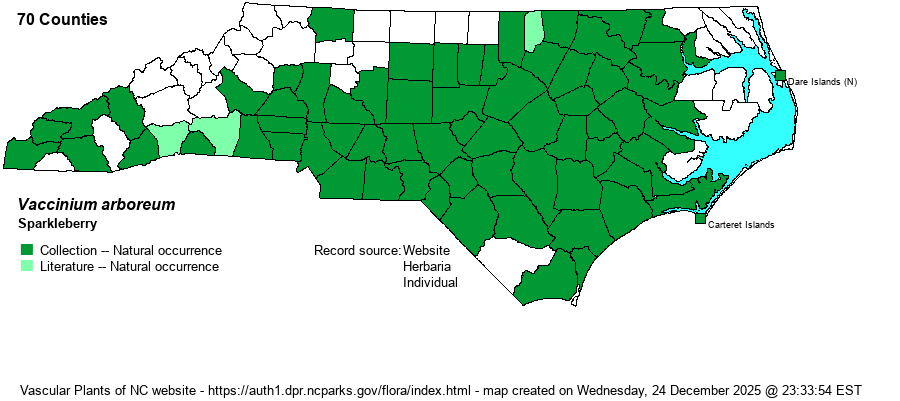| Author | Marshall | |
| Distribution | Nearly throughout the Coastal Plain and Piedmont; only a few locales in the lower Mountains, almost all close to the SC and GA border. Absent from most of the Mountains, portions of the northwestern Piedmont, and the far eastern portions of the Coastal Plain (i.e., nearly all counties north and south of Albemarle Sound). SERNEC shows specimens for Ashe and Watauga counties, but these are listed as "protected" with no data or image; owing to the high elevations of these counties, the editors are not adding them to the range map.
The species has a wide east-west range for an ericaceous species, ranging from southern VA and southern FL west to central TX and southeastern KS. It is absent, essentially, from the northern half of the country.
| |
| Abundance | Common and widespread over most of its Coastal Plain and Piedmont range. Rare to locally uncommon in the northwestern third of the Piedmont; very rare in the southern Mountains, except not scarce in parts of Cherokee County. | |
| Habitat | This is a widespread species in xeric and other dry to rocky or sandy forests. It often occurs on bluffs and steep slopes and ridgetops. Unlike most other ericads, it can be numerous on high pH soils, at least where sandy or rocky, such as on some Piedmont monadnocks over mafic rocks in the Uwharrie Mountains. It does not occur in wetlands or in moist soil. |
| Phenology | Blooms from late April into June; fruits in September and October. | |
| Identification | This is one of the few “tree” species of ericad, at least in the Southeast. It is easily identified by its tall stature, typically 10-30 feet tall, often with a single trunk; and by its evergreen or tardily deciduous leaves. Thus, in our area the “tree” remains green all winter. It has small (barely 1-inch long), rounded, dark green and shiny leaves that differ from nearly all other such woody plants in our area. When in bloom, the species is heavily adorned with an abundance of small white urn-shaped flowers that hang downward and are heavily used by insects for nectar. | |
| Taxonomic Comments | Generally not split into varieties, but the named variety V. arboreum var. glaucescens may have some merit as a recognized variety (fide Weakley 2018).
| |
| Other Common Name(s) | Farkleberry is almost as widely used as Sparkleberry. But, what is “farkle”, in terms of botany?! | |
| State Rank | S5 | |
| Global Rank | G5 | |
| State Status | | |
| US Status | | |
| USACE-agcp | FACU link |
| USACE-emp | FACU link |

